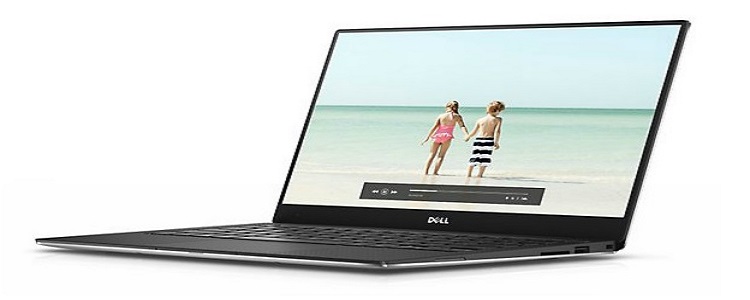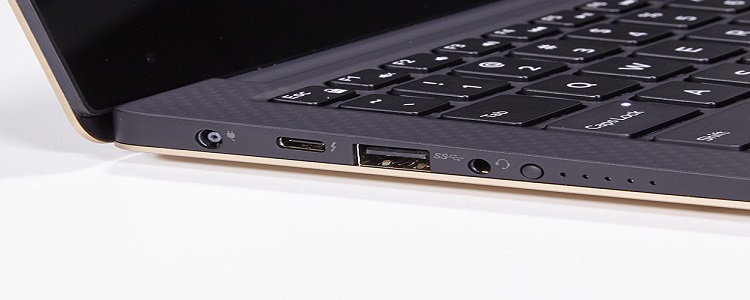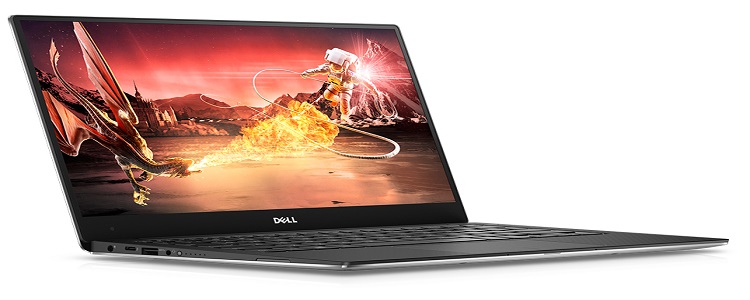The newest iteration of the Dell XPS 13 (Late 2016) is an ultraportable laptop that gives you all the reasons to be proud with its 13-inch screen with its infinity touch display. The sleek build and brilliant QHD+ touch screen carry from its predecessor that we reviewed earlier in the year, but it adds a seventh-generation Intel “Kaby Lake” Core i7 processor. It beats the competitors hands down, by striking a sweet spot in design, comfort, performance and battery life.
So far, it’s among the first laptops we’ve tested lately that includes a USB-C port with Thunderbolt 3 support, with the others being the ASUS ZenBook 3 and Razer Blade Stealth both released Q4 of 2016. All these releases have pushed competition in the high-end ultraportable category beyond normal levels, but the XPS9360-4841SLV has the build quality, performance, and battery life that should come with a premium system.
Design and Features
Quite dazzling, the latest XPS 13 Touch is constructed from superbly machined aluminum, with a top lid clad in silver while the palm rest is set on carbon fiber. It keeps the same frame from the previous model, measuring 0.6 by 11.98 by 7.88 inches (HWD), although its 11.2 ounces heavier at 2.7 pounds. It’s weightier and slightly thicker than the Asus ZenBook 3, which clocks 0.47 by 11.65 by 7.53 inches (HWD), and it weighs only 2.1 pounds, buts its aesthetics look somewhat bald unlike the elegant avant-garde blue with a golden ring we saw in the ZenBook 3 laptop.

The XPS 13’s Infinity display is, without a doubt, the most striking feature, and to that add a QHD+ (3200 x 1800) resolution. It’s also one of those features that made it possible for Dell to cram a 13-inch system into such a small chassis, ideally meant for an 11-inch notebook. The near-invisible bezels serve to minimize distractions, and for a minute I got a feeling that the display was floating above the base of the system. Whether you’re working on spreadsheets or on a Netflix binge-watching movies, distractions are reduced to the bare minimum.
The bezel design and higher-resolution display certainly outshine rival like the 13-inch Apple MacBook Pro and Asus ZenBook 3, both of which a bit-dated in comparison. The Razer Blade Stealth has a higher-resolution (4K Display–3840×2160), but the glaring keys and design shout “gamer” which might not be ideal for non-gamers. If you need to carry it around, you can slide it into the Bonvince 18.4″ Laptop Backpack, which has nicely placed compartments for the power adapter, mouse and other peripherals.
The touch screen is very responsive and the full-size, chiclet-style keyboard and one-piece touchpad are comfortable to use. The keyboard deck is solid with no flex; key travel and overall feel are top notch. The keys are backlit, as you’d expect on a premium system. Multitouch gestures are supported on the wide touchpad, if you don’t want to use the touch screen.

As mentioned, it’s one of the few laptops we’ve seen with the new USB-C port with Thunderbolt 3 support. This means that you can connect the system to Thunderbolt 3 and USB-C devices natively, and it will also interface with a DisplayPort monitor, HDMI-equipped displays, Thunderbolt (1 or 2), and USB (2.0 or 3.0) devices with an adapter. Dell offers a USB Type-C adapter that connects USB-C to Ethernet, HDMI, USB 3.0, and VGA – that’s if you need one along the
way. You can also charge the XPS 13 over USB Type-C, though it comes with a proprietary AC adapter. Other ports include a headset jack, a USB 3.0 port on the left side, and an SD card reader and another USB 3.0 port on the right side. For wireless connectivity, there’s dual-band 802.11ac Wi-Fi and Bluetooth 4.1.

The system comes with 8GB of memory and a 256GB solid-state drive (SSD). That’s plenty of space for many home users who stream music and videos instead of storing them locally. Surprisingly, the 8GB can be upgraded since the maximum memory the system can support is 8GB, though the storage is double what you get in the upcoming Dell XPS9360-1718SLV laptop.
Performance
Our review unit was configured with a 7th-generation Core i7-7500U (Kaby Lake) processor, 8GB of RAM and a 256GB solid-state drive with Intel HD Graphics 620. At 3.4GHz, this combination is as a fast as it would get for the Kaby Lake microarchitecture, providing superb performance on day-to-day tasks, even though the difference from the previous generation (Skylake) isn’t that substantial.
Put side-by-side with similarly configured laptops like the Asus ZenBook 3, the XPS 13 crunches the numbers pretty well. It will allow you keep a dozen tabs open on Chrome, while at the same time switch video streams on YouTube and a Netflix stream of the “Walking Dead” on an external display to a Skype Video call on the background. I did all that and the XPS 13 didn’t bulge.

For an ultraportable, the XPS 13’s Intel HD Graphics 620 scored quite well. If you attach it to an Xbox controller, you’ll get decent frame rates (FPS) on most games. Most games will give you decent frame rates of just over 27 fps on 1920 x 1080 at medium settings, although complex games such as GTA 5 will be a bit below playable levels, but you should easily be able to play less graphics-intensive games like Diablo III and Minecraft.
On battery life, the DELL XPS line as always been one of the long-lasting ultraportables, and in the new iteration with a Kaby Lake processor, it pushes the numbers even further. Dell includes a beefier 60-watt battery –previous models had 56 watts–, and the result is class-leading battery life. The system lasted 13 hours 51 minutes during testing entailing continuous movie streaming and surfing multiple tabs.
The ASUS ZenBook 3 (UX390UA-XH74-BL) gets 11 hours 56 minutes; which is close to the 12-inch MacBook (11:34), which is our former champs in battery life. The Apple MacBook (14:10) did better but you’re probably leaning toward a Windows 10 PC if you’re seriously considering the XPS 13 Touch.
Conclusion
In the end, the Dell XPS 13 (XPS9360-4841SLV) is one of those machines you should consider as you shop around. It packs a sleek, stylish build, a drool-worthy screen, and performance to match its looks. Although there are more compact 11- and 12-inch ultraportables out there, they make concessions for their smaller size, such as a lower-resolution screen, shorter battery life, fewer I/O ports, or a smaller keyboard. The XPS 13 Touch is only slightly larger, but retains a full roster of features.
It’s also lighter and slimmer than the Apple MacBook Pro 13-inch, and sports a sharper display and more storage. For all these reasons, the Dell XPS 13 (late 2016) is our Editors’ Choice for high-end ultraportable laptops, though the Acer Swift X SFX14-41G-R1S6 deserves a top spot in the list too. If Windows isn’t your OS of choice, however, then the 13-inch Apple MacBook Pro is a fine alternative.
